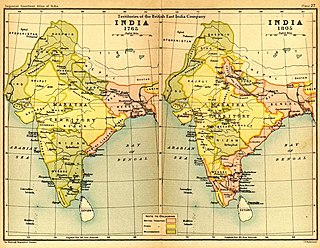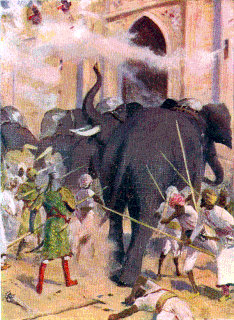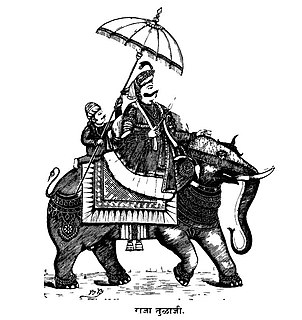Related Research Articles

Tipu Sultan, also known as the Tiger of Mysore, was the ruler of the Kingdom of Mysore based in South India. He was a pioneer of rocket artillery. He introduced a number of administrative innovations during his rule, including a new coinage system and calendar, and a new land revenue system, which initiated the growth of the Mysore silk industry. He expanded the iron-cased Mysorean rockets and commissioned the military manual Fathul Mujahidin. He deployed the rockets against advances of British forces and their allies during the Anglo-Mysore Wars, including the Battle of Pollilur and Siege of Srirangapatna, but the British took over the fort.

Hyder Ali, Haidarālī was the Sultan and de facto ruler of the Kingdom of Mysore in southern India. Born as Hyder Ali, he distinguished himself as a soldier, eventually drawing the attention of Mysore's rulers. Rising to the post of Dalavayi (commander-in-chief) to Krishnaraja Wodeyar II, he came to dominate the titular monarch and the Mysore government. He became the de facto ruler of Mysore as Sarvadhikari by 1761. During intermittent conflicts against the East India Company during the First and Second Anglo–Mysore Wars, Hyder Ali was the military leader.

The Second Anglo-Mysore War was a conflict between the Kingdom of Mysore and the British East India Company from 1780 to 1784. At the time, Mysore was a key French ally in India, and the conflict between Britain against the French and Dutch in the American Revolutionary War sparked Anglo-Mysorean hostilities in India. The great majority of soldiers on the company side were raised, trained, paid and commanded by the company, not the British government. However, the company's operations were also bolstered by Crown troops sent from Britain, and by troops from Hanover, which was also ruled by Britain's King George III.

The First Anglo-Mysore War (1766–1769) was a conflict in India between the Sultanate of Mysore and the East India Company. The war was instigated in part by the machinations of Asaf Jah II, the Nizam of Hyderabad, who sought to divert the company's resources from attempts to gain control of the Northern Circars.

The Anglo-Mysore Wars were a series of wars fought during the last three decades of the 18th century between the Kingdom of Mysore on the one hand, and the British East India Company, Maratha Empire, Kingdom of Travancore and the Nizam of Hyderabad on the other. Hyder Ali and his successor Tipu Sultan fought a war on four fronts with the British attacking from the west, south and east, while the Nizam's forces attacked from the north. The fourth war resulted in the overthrow of the house of Hyder Ali and Tipu, and the dismantlement of Mysore to the benefit of the East India Company, which took control of much of the Indian subcontinent.

Maruthanayagam Pillai, was the commandant of the British East India Company's Madras Army. He was born in a Tamil family in a village called Panaiyur in British India, what is now in Nainarkoil Taluk, Ramanathapuram District of Tamil Nadu, India. He converted to Islam and was named Muhammad Yusuf Khan. He was popularly known as Khan Sahib when he became a ruler of Madurai. He became a warrior in the Arcot troops, and later a commandant for the British East India Company troops. The British and the Arcot Nawab employed him to suppress the Polygar uprising in South India. Later he was entrusted to administer the Madurai country when the Madurai Nayak rule ended.

The Maratha Conquests were a series of conquests in the Indian subcontinent which led to the building of the Maratha Empire. These conquests were started by Shivaji in 1659 from the victory at the Battle of Pratapgad against Bijapur. The expansion of the empire was limited and interrupted by the Mughal conquests of south India by Mughal emperor Aurangzeb. Marathas were forced to defend their territories against the overwhelmingly strong Mughal army in the 27 years long Deccan wars. They were able to defend their territories and gain an upper hand over Mughals in the sustained conflict.

The CarnaticSultanate was a kingdom in South India between about 1690 and 1855, and was under the legal purview of the Nizam of Hyderabad, until their demise. They initially had their capital at Arcot in the present-day Indian state of Tamil Nadu. Their rule is an important period in the history of the Carnatic and Coromandel Coast regions, in which the Mughal Empire gave way to the rising influence of the Maratha Empire, and later the emergence of the British Raj.

Muhammad Ali Khan Wallajah, or Muhammed Ali, Wallajah, was the Nawab of Arcot in India and an ally of the British East India Company.

Chanda Sahib was a subject of the Mughal Empire and the Nawab of the Carnatic between 1749 and 1752. Initially he was supported by the French during the Carnatic Wars. After his defeat at Arcot in 1751, he was captured by the Marathas of Thanjavur and executed.

Thuljaji Bhonsle (1738–1787) was the eldest son of Pratap singh and the ruler of Thanjavur Bhonsle dynasty from 1763 to 1773 and 1776 to 1787. He was a weak-hearted ruler despite being extremely generous. His period is known for the treaties which made Thanjavur subordinate to the British East India Company.

Pratap Singh Bhonsle or Pratapsinha was the Maratha ruler of Thanjavur of the Bhonsle dynasty from 1739 to 1763. His rise to power followed three years of anarchy and civil war and restored the state to its previous greatness. His reign witnessed the Carnatic Wars and the Seven Years' War.
The Treaty of Mangalore was signed between Tipu Sultan and the British East India Company on 11 March 1784. It was signed in Mangalore and brought an end to the Second Anglo-Mysore War.

The siege of Arcot took place at Arcot, India between forces of the British East India Company led by Robert Clive and forces of Nawab of the Carnatic, Chanda Sahib, assisted by a small number of troops from the French East India Company. It was part of the Second Carnatic War.
The Maratha–Mysore Wars was a conflict in the 18th century India, between the Maratha Empire and the Kingdom of Mysore. Though initial hostilities between the sides started in 1770s, the last warfare began on February 1785 and ended in 1787.

The siege of Trichinopoly was part of an extended series of conflicts between the Nizam of Hyderabad and the Maratha Empire for control of the Carnatic region. On 29 August 1743, after a six-month siege, Murari Rao surrendered, giving Nizam ul Mulk (Nizam) the suzerainty of Trichinopoly. By the end of 1743, the Nizam had regained full control of Deccan. This stopped the Maratha interference in the region and ended their hegemony over the Carnatic. The Nizam resolved the internal conflicts among the regional hereditary nobles (Nawabs) for the seat of governor (Subedar) of Arcot State, and monitored the activities of the British East India company and French East India Company by limiting their access to ports and trading.
The siege of Trichinopoly (1751–1752) was conducted by Chanda Sahib, who had been recognized as the Nawab of the Carnatic by representatives of the French East India Company, against the fortress town of Trichinopoly, held by Muhammed Ali Khan Wallajah.

Tiruchirappalli is believed to be of great antiquity and has been ruled by the Early Cholas, Mutharaiyars Early Pandyas, Pallavas, Medieval Cholas, Later Cholas, Later Pandyas, Delhi Sultanate, Ma'bar Sultanate, Vijayanagar Empire, Nayak Dynasty, the Carnatic state and the British at different times. The archaeologically important town of Uraiyur which served as the capital of the Early Cholas is a Neighborhood of Tiruchirapalli.

Tiruchirappalli Fort is a dilapidated fort in India which once protected the Old City of Trichy encompassing Big Bazaar Street, Singarathope, Bishop Heber School, Teppakulam and Tiruchirapalli Rock Fort. All that remains now is a railway station with that name and Main Guard Gate along West Boulevard Road in the city of Tiruchirappalli in Tamil Nadu. The fort can be traced along West Boulevard Road in West, East Boulevard Road in East, Butter-worth Road in North and Gandhi Market to the South.

The Mysorean invasion of Malabar was the military invasion of the Malabar region of Kerala, including the territories of the Zamorin of Calicut, by the then-de facto ruler of the Kingdom of Mysore, Hyder Ali. After the invasion, the Kingdom of Cochin to the south of Malabar became a tributary state of Mysore.